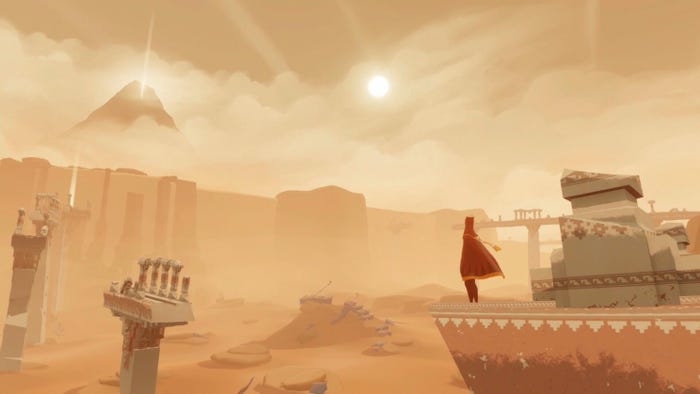
Featured Blog | This community-written post highlights the best of what the game industry has to offer. Read more like it on the Game Developer Blogs or learn how to Submit Your Own Blog Post
Fine-tuned tales: How gaming music tells stories
Music has the remarkable capacity to share with graphics and writing the task of telling a story in video games. So how can developers go about it?

When people think of stories in games, they likely view them the same way they perceive novels and films: Plot, character, events, and what folks say propel things forward.
While those writerly facets do apply to interactive entertainment and can be leveraged to great effect, it's also true that as an audiovisual medium, gaming can make use of something other than the written or spoken word to get its narrative points across. This was especially true back in the old days when limited console hardware precluded developers from whipping up the kind of cinematic moments that'd rival anything Hollywood could offer.
It's in this context, then, that one notices where games can evoke narrative meaning when the traditional storytelling approach utilized in passive mediums like literature and movies can't be effectively taken advantage of. Hint: It's something one generally notices in the background.
Enter the realm of video game music, where the tunes can be as catchy and ambient as they are narratively impactful.

From the harmonic humming that echoes about the soundscape while exploring Mt. Firmament in Wuthering Waves (2024) to the skillful use of different instruments to highlight locational and narrative thresholds in Journey (2012), music bears the remarkable capacity to share with graphics and writing the task of telling a story in a medium that asks one to look at/listen to more than just words and actively partake in an adventure of their own making.
More impressively, music can make or break a story or parts of it in ways that'll have players readily recollect the moment they experienced it all just by listening to the track(s) in question.
Given the above, then, developers would be wise to explore such an auditory avenue in the name of crafting a transcendent narrative experience. Through an understanding of a title's themes, characters, tone, events, and setting, game makers can craft tracks that can tell a story more vividly than if achieved solely via in-game dialog and cinematic sequences. Better yet, said tracks can shine a light on themes and emotions relayed through graphics and/or words.
One can even say that music and other game aspects may work in concert to tell a quality tale.

NOTE: The tips in this article may or may not be compatible with every game depending on the designer's vision, but they serve as general tenets that can benefit the experience when well implemented. Spoilers may crop up since details about the games' stories will be discussed.
Music Can Relay: A Particular Character's Experience in the Narrative
As with stream-of-consciousness and dialog, music can be used to clue folks in on a character's personal experiences that bolster the story's emotional impact. While not as obvious as having said theme spelled out, such musical subtleties can still prove potent.
Two ways to achieve this via music are a) having lyrics that reflect the emotional throughline of a character in the story and b) using few or many instruments that make the music's subject matter sound fittingly minimalistic or grandiose. Bonus points if the track contributes to the story's overarching themes and sounds like something that matches the onscreen action.
Having a leitmotif accurately rendered can require disciplines such as audio, writing, art, and even level design to come together and ensure the track in question is showcased as intended.
One series that has consistently delivered riveting OSTs that complement and enhance the narrative in each entry is Silent Hill (1999 - Present). Akira Yamaoka's musical work on the horror franchise never fails to illuminate the titular town's eerie vibes and tragic stories.
This can be observed in many tracks that hint at a character's trials and experiences. "End of Small Sanctuary" in Silent Hill 3 (2003), for instance, emphasizes Heather's adolescent and rebellious self through guitar riffs and drumbeats—with the track name itself foreshadowing the protagonist's first monstrous encounter. Likewise, "Elle Theme" in Silent Hill: Homecoming (2008) makes great use of meaningful lyrics and an echoing piano effect to underline the unfortunate events that have struck the town of Shepherd's Glen prior to the story's outset.
The recurring outcome, then, is the feeling that any character tied to and/or stepping into Silent Hill comes with their own emotional baggage and must be willing to unpack and confront their woes if they are to let go of old travails and be able to walk away enlightened.
Music Can Relay: The Story's Current Overarching Mood
The aphorism "A picture can be worth a thousand words" is a well-known mantra, yet it's similarly true that music can describe something that words alone can't do justice to—if at all.
In fact, music can be an effective tool for spotlighting narrative details in case developers want to have players fully immersed in the title's atmosphere to get their storytelling points across—something the presence of words may detract from if the writing's relatively overwrought. Not to mention the fact that when dealing with a character's unspoken state of mind or a location that's deserted, music can complement audiovisual touches that tell a story in words' place.
That said, it's crucial for developers to strike a happy medium between making things too subtle for the average player to readily appreciate and so overt that gamers will feel like they're being lectured in a way. If successfully scored, a musical track can have a lasting impact on players in terms of how they perceive and think about a specific moment in the game.
SIGNALIS (2022) is a sterling example of what can be achieved via music from a storytelling standpoint, especially given how minimalistic and ambiguous the tale can be as a whole.
This makes traditional narrative delivery tools like dialog and cutscenes less conducive to elegantly showing players what they're dealing with in the here and now. This is particularly true of Ariane, a character in the story whose plight plays a crucial role in the title's plot.
As gamers uncover more of her past, they start to piece together a picture of a girl who struggles to fit in pretty much wherever she goes. This feeling of dejectedness is peerlessly encapsulated in the track "Train Ride," which plays during a flashback sequence showing a doleful Ariane sitting all alone inside a train car surrounded by a gloomy and snowy urban landscape. The track's melancholy tones and fleeting length reflect the fact that Ariane's hopes for a purposeful life on the planet of Rotfront are short-lived at best and nonexistent at worst.
Not a single word's uttered during that scene, reinforcing the idea that the silence is pregnant.
Music Can Relay: A Particular Story Event's Dynamism
The same way that words can be made punchier or more subdued to reflect the characters' state of mind, a track can go through sundry phases within a few minutes to heighten or downplay the different levels of tension in an event the player observes and/or partakes in.
Not only is musical dynamism great for making the track in question sound well-paced and therefore less likely to come across as white noise, but it can also keep up with the onscreen action and make a technically lengthy gameplay bit feel quite breezy. Sort of like how engaging conflict in a story can mask its runtime and the amount of exposition it dishes out.
Better yet, dynamic music tracks can be effectively used to fittingly capture the lyrics' emotional resonance—turning things up to 11 at one point and dialing them down at another so that players can feel that different wavelengths are at play. Much like how the action in a story ebbs and flows, great music must provide auditory twists and turns along the way to keep players engaged and make the event they witness feel like more than the sum of its parts.
Such is the state of affairs with "Bury the Light," a track from Devil May Cry 5 (2019) that represents Vergil's battle theme. On top of sporting lyrics that hint at Vergil's past struggles and need to hold onto his humanity, the battle song pulls no punches in the tonal department.
This can be keenly observed in the difference between the song's verses and chorus, with the former taking on a contemplative character that hints at Vergil's more vulnerable self in the past and the latter oozing the kind of confidence only someone who's been through many trials can give off while hacking away at baddies. Such an effect is only magnified by Devil May Cry 5's being a high-octane and character-driven action title, making the presence of "Bury the Light" all the more important in terms of telling a story without putting combat bits on hold.
To say that the track strikes players as an emotional rollercoaster during the segments it plays in would be an understatement. If anything, "Bury the Light" shows that just because a game has more time for hacking 'n slashing than for talking doesn't mean that developers can't hint at a character's demeanor and backstory. That it can (further) improve a player's impressions of "the storm that is approaching" just by listening to his battle theme doesn't hurt either.
Music Can Relay: The Vibes of the Setting (And Players' Place in It)
Few feelings are as palpable as the one players embody whenever they immerse themselves in a virtual world with a strong sense of place. It's something that game aspects such as graphics, level design, art, and audio can achieve as a happy collective when they're all designed to serve the same creative vision that developers hold onto while making their ideas manifest.
Where music is concerned, ambient notes and/or impactful leitmotifs can imbue a setting with character and compel players to explore their surroundings—if only to see what other sights and sounds they may stumble upon. It's therefore not surprising that YouTube hosts many videos dedicated solely to depicting game environments, allowing players to slow down and smell the proverbial roses. That such locational tracks can potentially tell a story without needing NPCs to talk to, notes to find, or lyrics to listen to speaks volumes of their potency.
This can be a challenge if the tracks in question are to cover large swaths of virtual terrain, especially those with varied biomes and backstories. But an understanding of the title's overall vibes and how players perceive them from their place in the game world can make a difference.
One game setting with different tonal shades to account for is the planet of Pandora from the Borderlands series (2009 - Present). As a Mad Max-inspired role-playing shooter with gobs of dark humor and wacky personalities, Borderlands may not strike folks as a title that puts a premium on awing gamers via the exotic nature of its virtual setting. At first glance, at least.
However, the fact of the matter is that Pandora—for all its zany goings-on—is still relatively uncharted territory for corporate souls and fortune hunters trying to eke out a living in a corner of the universe they're strangers in. This is something that composer Jesper Kyd likely picked up upon, inspiring him to compose sundry tracks that hint at the perils and wonders that Pandora has to provide. One of these tracks is the night version of the main menu screen in Borderlands 3 (2019), with its distant techno melody and synthwave notes driving home the otherworldly vibes players detect upon landing on Pandora and while venturing around it.
While the series' actual stories are more concerned with individuals and factions fighting over resources and treasures, the OSTs themselves do a stellar job portraying Pandora as a place gamers can flee to and be mesmerized by if they take the time to relish its sights and sounds.
Music Can Relay: The Backstory of a Place and Its Inhabitants
On top of hinting at the vibes of a setting, music can say a lot about a location's backstory and what it's dealing with in the here and now. This applies both to abandoned spaces with no dialog to listen to or notes to read and to populated areas with lots of folks to talk to.
What's great about letting music tell the story of what a specific locale went through to become what it is today is that it can be interpreted as something that does the talking for those who inhabit it (or once inhabited it). Such an approach allows players to spend less time looking about their surroundings for clues about and information on a particular place and more time taking in the sounds as a way of sizing up the state of the environment they're in.
As always, penning a track that harbors the story of a location that has seen better days or is in its prime requires the audio team to thoroughly understand the narrative, art style, and layout of the space they're scoring a tune for. Success in that department begets a soundscape that gorgeously captures the triumphs and trials of the location in question with few to no words.
This can be observed in Chained Echoes (2022), a love letter to JRPGs of yore that heavily pays tribute to its inspirations via a lively and colorful score courtesy of Eddie Marianukroh. From the hauntingly beautiful chanting that defines Perpetua Flower Fields to the sunny vibes that Farnsport gives off via its track, every tune in Chained Echoes sounds distinct enough for players to immediately recognize the spot in which it plays—hardly a small feat in an RPG.
A key standout would be "The Rainy City of Tormund." Players reach the titular city deep in their adventure. Before arriving at the settlement, gamers will already be aware of the fact that its leadership doesn't exactly have the interests of its people in mind. If the gloomy sky and constant rain in and around Tormund don't convince players that they entered a place of despair, then the melancholy melody playing in the background will most likely get to them. Long story short, Tormund has seen better days, and it's up to players to make things right.
Perhaps the best part about Chained Echoes' OST is that the sheer variety of tracks that cover a wide range of emotions and locations lets gamers know that they're indeed making steady progress in the main quest. And along the way, they'll encounter all kinds of twists and turns that'll have them feeling triumphant and despondent—something the music is happy to reflect.
Music Can Relay: The Player's Impact on the World and Narrative
Musical dynamism isn't something that solely arises from how a scripted event plays out. There's also the fact that tracks can evolve depending on what players do to shape their circumstances and surroundings, which can alter the tunes' texture and make them feel more layered than if they always bore the same vibes and wavelengths while gamers explore an area.
This, of course, is applicable to titles that allow gamers to make their mark on the world more tangible and persistent—with the music adapting to player-made changes to drive home the fact that what they are doing is less of a one-off and more akin to an indelible ink spot.
On the narrative side of things, music that changes depending on what one does to their surroundings can inform them of how they're making things better or worse for those who call the impacted area home. This can either compel players to keep the ball rolling in the same direction or to course correct, all without a single line of dialog being uttered to let them know that they might need to rethink matters. Bonus points if the visuals match the auditory tweaks.
This is a musical aspect that Epic Mickey (2010) excels in thanks to the painting mechanic that the titular mouse has access to from the get-go. Depending on their playstyle and moral predilections, gamers may choose to shower the game world with either restorative paint or corrosive thinner that renders the levels they trek across cheery or depressing respectively.
While the visual changes themselves are already stark, this is to say nothing of how adaptive the music can be. OsTown, for instance, boasts a lighthearted melody courtesy of the area's colorfulness and lack of corruptive thinner gnawing away at the infrastructure. Should players choose to preserve/improve their surroundings, the track will stay chipper while bearing a hint of melancholy in the background. A different tune arises, though, if Mickey mucks things up.
Between the change in instruments and the sound of low droning, OsTown's music can become much less mirthful—letting players know right away what they've done. It's a testament to Jim Dooley's scoring chops that OsTown's tonal variations stand out from one another, further contributing to the narrative throughline that is Mickey's attempt to fix what he has broken and his dealings with a part of Disney's past the protagonist wasn't aware of.
Thank you for reading! Feel free to share this article with your friends.
About the Author
You May Also Like








.jpg?width=700&auto=webp&quality=80&disable=upscale)
_(1).jpg?width=700&auto=webp&quality=80&disable=upscale)